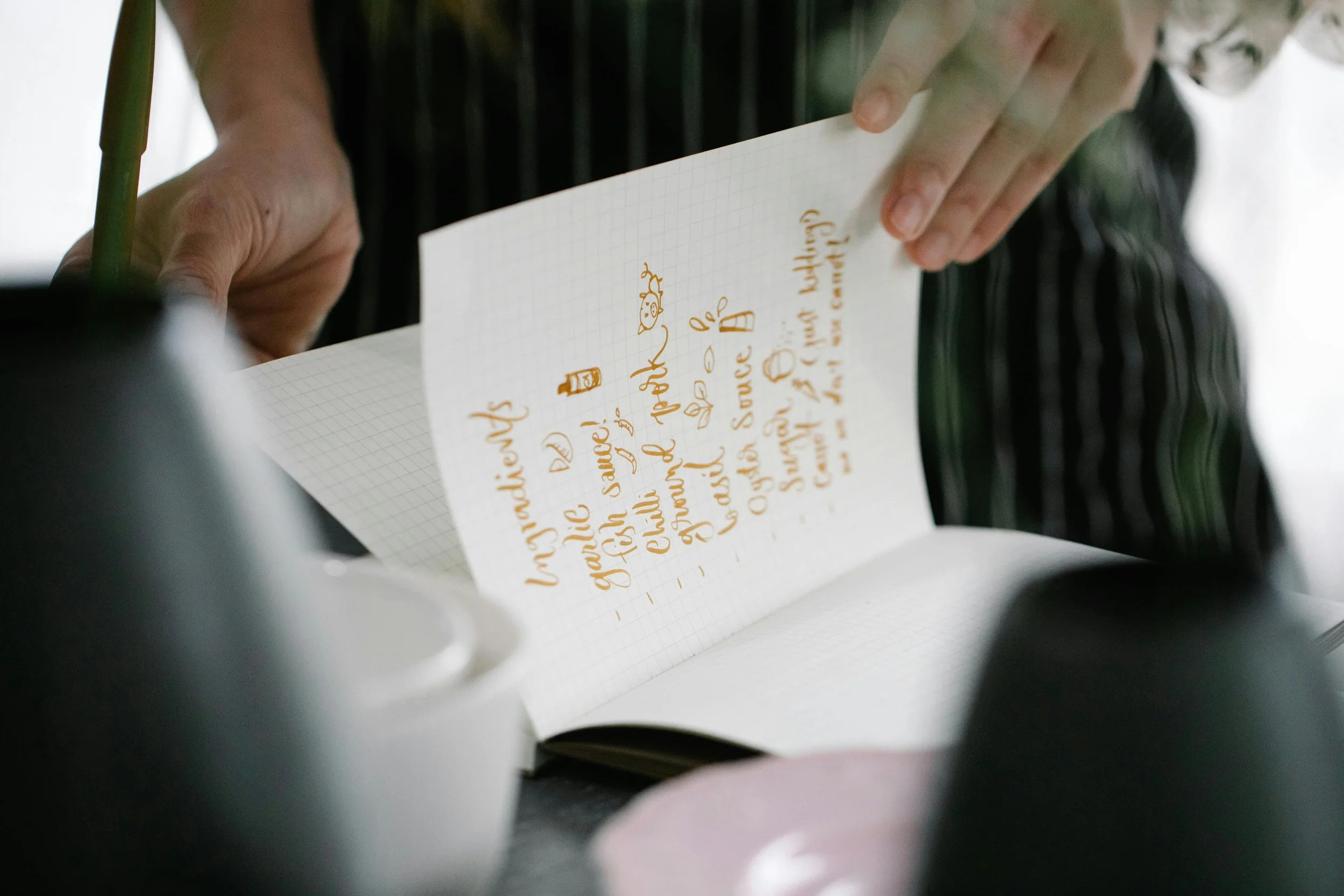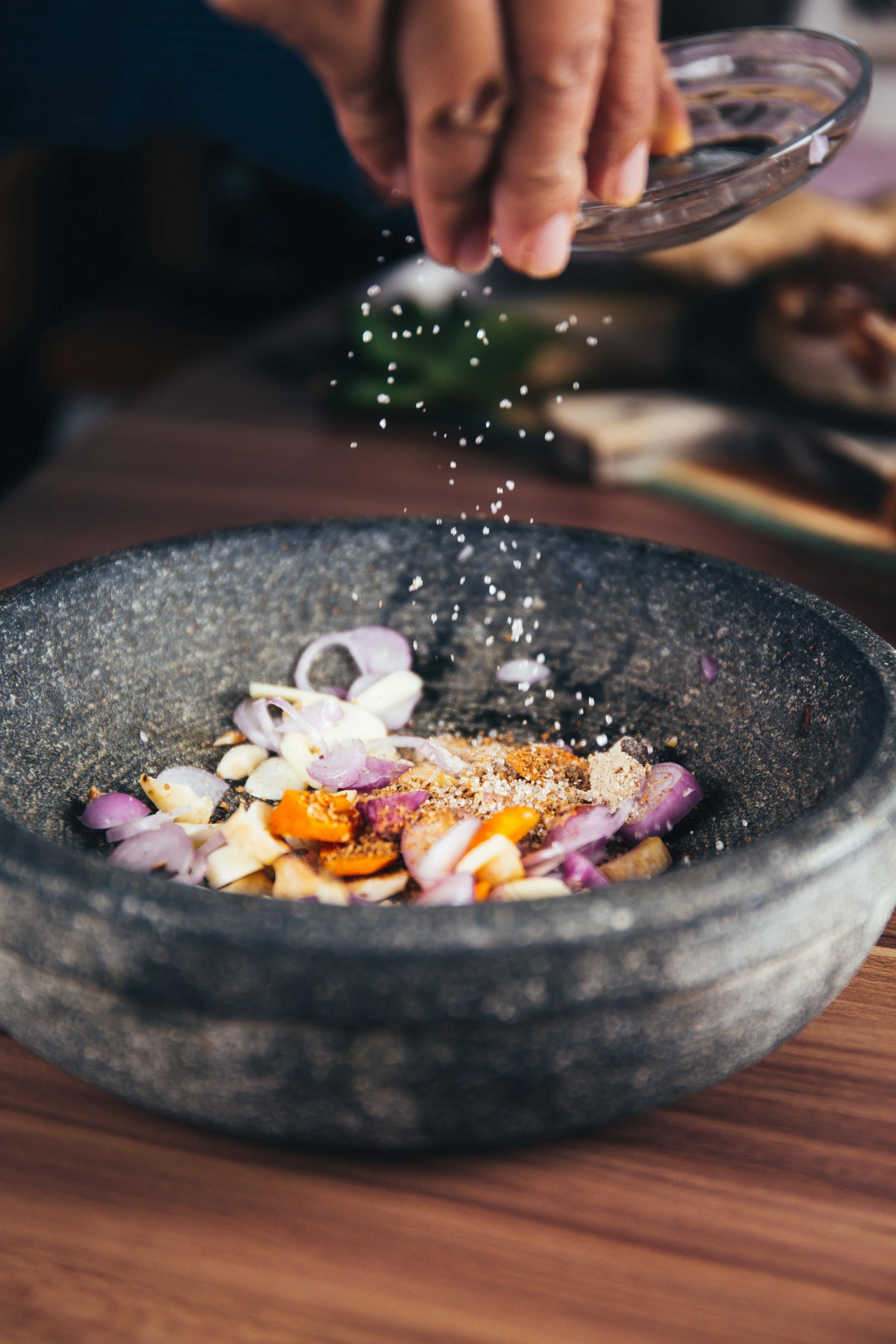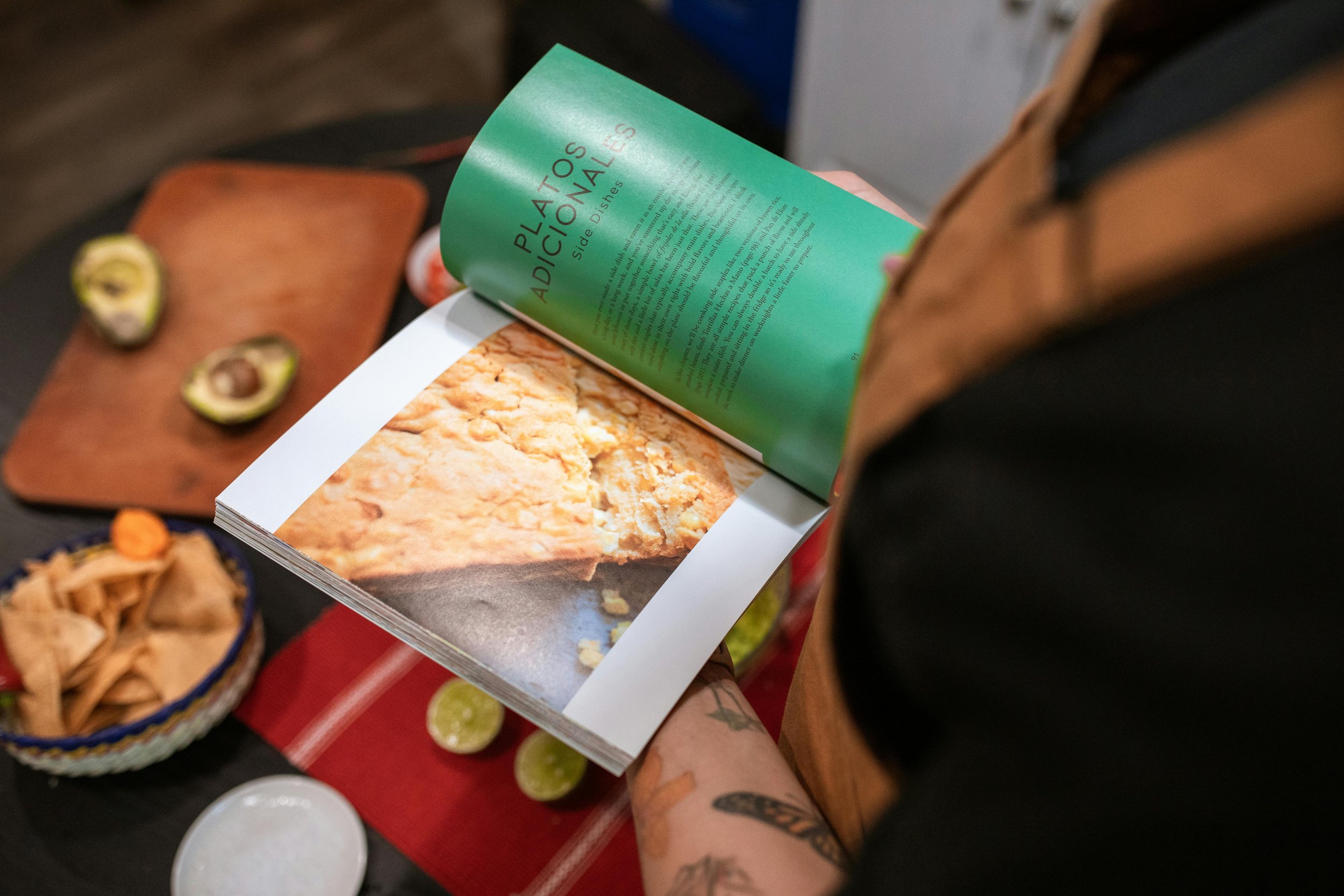No Recipe? No Problem! How to Cook with Confidence and Love
I still remember the first time I asked my dad for his famous beef stroganoff recipe. I was ready — notebook in hand, pen clicked, fully prepared to write down exact measurements like a good little kitchen soldier. Instead, what I got was a whimsical mess:
"Oh, a dash of this... a handful of that... a spoonful here... just season it with your heart."
Season it with my heart?
I stood there blinking, wondering if I had accidentally wandered into a Disney movie. I didn’t need magic — I needed clear, numbered steps and precise measurements. How much is a dash? What does a "handful" even look like? Whose hand are we talking about here?
At that moment, the idea of "cooking with love" felt more like a cruel inside joke that some people were blessed with, and others (like me) were cursed to admire from the sidelines.
If you've ever felt the same — a little envious of the "just toss it in!" crowd, frustrated by vague directions, and wondering if you'd ever be able to just wing it in the kitchen — this post is for you.
Because here’s the good news:
Cooking with love isn’t a magical gift. It’s a skill you can build.
And by the end of this post, you'll know exactly how to trust yourself more, loosen your white-knuckled grip on the measuring spoons, and cook meals that are not only delicious but proudly yours.
So the next time someone asks you how you made that incredible dinner, you’ll smile — maybe even a little smugly — and say, "With love,"
...and you'll actually mean it.
Trust Your Taste Buds and Learn Flavor Basics
The first step to cooking with confidence (without clinging to a recipe like a life raft) is simple: trust your taste buds.
Yes — yours. Not Sam Sifton's, not some professional chef’s. Yours.
Good cooks — even gourmet chefs — didn’t get there because they were born with some mystical power. They got there because they tasted as they cooked. They messed up. They added a little salt here, a drizzle of olive oil there. Sometimes they made a good meal. Sometimes they made a total disaster and had to order pizza.
That’s all part of the joy of cooking.
Here’s the truth: if you want to cook like the folks over at New York Times Cooking or channel your inner Samin Nosrat, you have to start experimenting with flavor profiles.
Taste things as you go. Notice how adding a splash of vinegar wakes up a boring potato salad, or how a pinch of cinnamon transforms plain French toast from "eh" to "wow." And at first, if you’re having difficulty grasping that “creative side”, it’s fine! That’s what trusty Google is for. (Or these days, AI is super helpful.) When you’re cooking a classic dish, try researching “good flavor pairings with…”
(And yes, you will make some weird stuff at first. That’s half the fun.)
Simple Tip: Messed Up? Improvise!
Too salty? Add a splash of water, a squeeze of lemon juice, or toss in a starchy side like rice or bread to absorb it.
Too bland? Try a little salt, a squeeze of citrus, or a sprinkle of fresh herbs.
Too dry? A drizzle of olive oil or a ladle of broth can bring it back to life. (Pro move: always keep a bit of broth or sauce nearby, just in case.)
Think of it like sheet music for a song:
At first, you need to read every note carefully. But over time, you start to hear the rhythm, you feel the music — you play by ear.
Cooking is the same. Recipes are your sheet music. Intuitive cooking is the jam session.
Soon, you’ll be building your own good meals without even pulling out a recipe card, or flipping through your debut cookbook for help. You'll walk through grocery stores with ideas buzzing in your head: maybe a quick one-dish meal tonight? Some new main courses to mix into the meal plan? Maybe try new flavors with those chicken breasts you always buy?
The only way to get there is by practicing. By tasting. By trusting yourself.
Next time you’re tempted to measure the tomato sauce down to the last teaspoon, stop. Pour it in, give it a stir, and then — taste it. Adjust from there.
Mistakes are not failures — they’re flavor experiments.
Master Basic Methods and Cooking Techniques
If trusting your taste buds is step one, mastering a few basic cooking techniques is step two.
Because the real secret of confident cooks isn’t that they know a million different recipes — it’s that they know different ways to cook the same ingredients.
It’s like having a bag of cookie cutters: the dough (your ingredients) stays mostly the same — you’re just shaping it into something different each time.
Good cooking starts with knowing a few key methods:
Sautéing (think stir-fries or quick veggie sides)
Roasting (like those crispy chicken breasts or sheet pan veggies)
Simmering (soups, tomato sauce, cozy stews)
Grilling (perfect for pork chops or summer veggies)
Slow cooking (hello, hands-off healthy meals in the slow cooker)
Sous vide (if you're feeling fancy — and have a lot of time)
Once you’re comfortable with these basic methods, suddenly you don't need a new recipe every night.
You can glance at your fridge, see some carrots and leftover chicken, and boom — you're already brainstorming a good meal.
Common Cooking Replacements and Kitchen Improvisations
Let’s say you’re halfway through the cooking process and you realize you're missing something.
First of all: Don’t panic. This happens to even professional chefs (ask any family member who’s seen a chef at home realize there’s no garlic... chaos).
Here are some simple tips for improvising:
No heavy cream for a sauce? Use whole milk with a pat of butter.
No fresh herbs? Dried herbs work — just use less (they're stronger).
Out of eggs for french toast? A little mashed banana or even yogurt can step in.
No lemon for brightness? A splash of vinegar wakes things up.
Missing broth? Water + a pinch of salt will get you 80% there.
No tomato sauce? Blend canned tomatoes with olive oil, garlic, and salt — instant homemade sauce!
Improvising is part of building your cooking skills — it's about seeing new things not as problems, but opportunities for new flavors.
(The Flavor Bible, if you ever check it out, is an incredible tool for learning natural flavor pairings — but honestly, you’ll start developing your own personal favorites just by trying things. Want to check The Flavor Bible, click here)
When you’re starting out, you don’t have to invent the next debut cookbook.
You just need to know enough methods and swaps to keep the meal moving, even if the original recipe format gets a little... "creatively adjusted."
Remember:
Cooking is forgiving.
Mise en place (getting all your ingredients ready first) helps a lot.
Next time you’ll know what to tweak before disaster strikes.
And every mistake? It’s just adding more to your cooking experience.
Keen cooks don’t become confident by never messing up — they become confident because they keep going after they mess up.
How to Start Cooking Intuitively: Small, Easy Wins You Can Try Tonight
Alright, you’ve trusted your taste buds. You’ve learned the basic methods.
Now it’s time for the real magic: intuitive cooking.
Home cooks often think that being able to "just whip something up" is reserved for professional chefs.
(Or some mythical family member who can make potato salad without measuring a single thing and it somehow tastes better every time.)
But here’s the truth:
You don’t need a culinary degree.
You don’t even need a lot of time.
You just need to start small — and keep your eyes, nose, and taste buds open.
Easy Ways to Build Intuitive Cooking Skills:
1. Start by Tweaking Your Favorite Recipes
Pick one of your favourite recipes — something you know pretty well.
Next time you make it, change just one thing:
Swap the herb (thyme instead of basil in your tomato sauce).
Add a squeeze of lemon over your chicken breasts right before serving.
Throw some chili flakes into your usual sheet pan veggie roast.
Small changes lead to big flavor discoveries.
(And bonus: if it’s a disaster, at least it’s a familiar disaster.)
2. Use Ingredients You Already Have
Instead of running to grocery stores because you’re out of the "right" thing, look around.
Cooking with confidence means knowing you can substitute and still create delicious meals:
No potatoes? Try roasted carrots or sweet potatoes for your next one-dish meal.
No pork chops? Use chicken thighs — same roasting method, new flavor.
No salad dressing? Whisk together olive oil, vinegar, a dab of mustard, and a little salt. Done.
The cooking process is flexible — not a court trial.
3. Build Your Flavor Library
Think of yourself as creating your own internal Flavor Bible over time.
You’ll naturally start to recognize flavor profiles and flavor pairings:
Tomatoes love basil, balsamic, and mozzarella.
Pork loves apples, rosemary, and mustard.
Chocolate loves coffee, cinnamon, and chili.
First time trying a combo? Great! Take a bite, adjust, keep learning.
(New Zealand lamb with mint? French roots. Potato salad with dill? Classic American. Flavor travels fast.)
4. Practice With Low-Stakes Dishes
Want to practice new things without the fear of ruining dinner?
Start with low-risk experiments:
Salad dressings
French toast toppings
Tomato sauce tweaks
Slow cooker soups where you can taste and adjust as you go
When you’re not up against time limits or feeding 10 people, you’re free to explore.
5. Trust Your Gut (and Your Nose)
Your senses are your key ingredient to success:
Smell your spices before you use them.
Taste the sauce halfway through.
Listen to the sizzle when sautéing — is it too quiet (too cold) or too aggressive (too hot)?
The first step to being a good cook isn’t perfection — it’s paying attention.
Remember:
You don’t have to abandon recipe recipes entirely.
Think of them more like guidelines, not the law.
Good cooks rely on both structure and intuition.
And when you do want a little structure, dive into places like New York Times Cooking, flip through your debut cookbook, or even browse a few cooking classes online. (Sometimes you pick up a new technique in 5 minutes that changes everything.)
Over time, you’ll develop cooking skills you can rely on — whether you're searing pork chops, roasting veggies, or whipping up a pasta sauce with whatever’s left in the fridge.
And next time someone asks how you made dinner, you’ll finally smile and say it:
"I just cooked with love."
(And you’ll mean it.)
Wrapping It All Up: You’ve Got This
Learning how to cook with confidence without a recipe isn’t about waking up one day and suddenly tossing ingredients around like a gourmet chef.
It’s about small moments, small risks, and building trust in yourself a little at a time.
Here are some simple tips to always keep in mind:
Start small. Swap just one thing at a time in your cooking.
Taste often. Your senses are your best teachers.
Mistakes are good. They’re how you learn (and sometimes invent your personal favorite meals).
Stay curious. Try new spices, explore different recipes, experiment with different ways of cooking.
Use what you have. Flexibility in the kitchen is your superpower.
A Challenge for Your Next Meal
The next time you’re following one of your favourite recipes, try this:
Pause for a moment.
Ask yourself:
What gives this dish its zest?
What’s your favorite thing about it?
Is it the bright lemon in the salad dressing? The deep garlic flavor in the tomato sauce?
Then think:
How could you tweak it?
How could you make it your original recipe?
Maybe you add a splash of chili oil to that pasta sauce.
Maybe you swap honey for sugar in your first French toast recipe.
Maybe you toss fresh mint into your usual potato salad just to see what happens.
That’s how you start transforming from someone who "relies on the book" to someone who writes their own internal cookbook every time you cook.
Final Thought
Cooking isn’t about being perfect.
It’s about building confidence, one sizzling pan and one pinch of salt at a time.
You already have the most important ingredient — the willingness to learn, to taste, and to try.
And that’s what the joy of cooking is really about.
Next time you're standing in your kitchen, remember:
You’re not just following a recipe —
You’re creating something with heart,
With your senses,
With love.
And before you know it, you’ll be the one tossing in a "dash of this" and a "handful of that" — and smiling when someone asks you for your secret.
Quick Kitchen Fix-It and Swap-It Sheet (Print or Screenshot!)
Common Ingredient Swaps
If a recipe calls for:
Buttermilk: Use regular milk + a splash of lemon juice or vinegar.
Heavy cream: Use whole milk + a bit of butter.
Fresh herbs: Use dried herbs (but use only ⅓ as much).
Chicken broth: Use water + a spoonful of bouillon or a little soy sauce for depth.
White wine: Swap with chicken broth + a squeeze of lemon.
Brown sugar: Use white sugar + a tiny drizzle of molasses or maple syrup.
Breadcrumbs: Crush crackers, cornflakes, or oats.
If You’ve Overseasoned...
Too Salty?
Add a splash of water, broth, or unsalted tomato sauce.
Add a starchy food (rice, potatoes, pasta) to soak up excess salt.
A little cream, coconut milk, or even a splash of vinegar can balance saltiness.
Too Spicy?
Add dairy (milk, sour cream, yogurt, coconut milk).
Add something sweet like honey, sugar, or a mild tomato sauce.
Serve it with a starchy side to dilute the heat (rice, bread, potatoes).
Too Acidic? (like too much vinegar, tomatoes, or lemon?)
Add a pinch of sugar or drizzle of honey.
Stir in a pat of butter or a splash of cream to mellow it out.
Too Bland?
Add a pinch more salt — it might be all it needs!
Add acid: a squeeze of lemon or a dash of vinegar wakes up flavors.
Add fat: a drizzle of olive oil, a pat of butter, or a spoonful of cream brings richness.
Toasted spices, fresh herbs, or a sprinkle of cheese can instantly add more flavor.
Remember:
Taste as you cook — don't wait until the end!
Small adjustments first. You can always add more, but you can’t take away.
Balance is key — salt, acid, fat, and sweet work together.
Save this cheat sheet for your next cooking adventure! Click here
You'll be ready to tweak, fix, and invent on the fly — just like a pro (or better yet, like a home cook cooking with love). ❤️





